A constellation of the southern sky, the northern part of which at best only touches the southern horizon from below at midnight in mid-February in our latitudes, so we can practically never see it. The only option is to travel far south, where this majestic constellation, located in the Milky Way, rich in star clusters and nebulae, rises higher above the horizon. The Sails, along with the Stern, Keel and Compasses, are part of the old, vast constellation of the Argo Ship. After its division, Sails lost its α and β stars to the Keel, and its brightest star became γ Velorum.
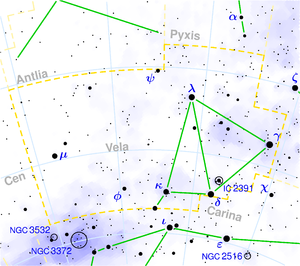 The brightest part of the Milky Way in the constellation is around the relatively prominent open cluster IC 2395 (4.6mag). Several constellations also emerge from it. The surroundings of most of the brightest stars of the Sail pattern give a hazy impression. γ Velorum due to the abundance of nearby 6th magnitude stars and the bright cluster NGC 2547 (4.7mag), λ Velorum due to the small local brightening. Close to δ Velorum lies a very prominent one-degree spot, the open cluster IC 2391. δ Velorum, together with the stars κ Vel and ε and ι Carinae of the Keel, form the so-called False Cross, which is often confused with the true Southern Cross by northern sky admirers. Unlike the latter, however, it is slightly larger, more symmetrical and less bright, and its arm does not point to the region of the south celestial pole. Between the two crosses, you can find the obsolete constellation of Karl's Oak. The latter was a reminder of the huge tree trunk in Boscobel in which King Charles II of England hid day and night after his defeat by Oliver Cromwell in 1651.
The brightest part of the Milky Way in the constellation is around the relatively prominent open cluster IC 2395 (4.6mag). Several constellations also emerge from it. The surroundings of most of the brightest stars of the Sail pattern give a hazy impression. γ Velorum due to the abundance of nearby 6th magnitude stars and the bright cluster NGC 2547 (4.7mag), λ Velorum due to the small local brightening. Close to δ Velorum lies a very prominent one-degree spot, the open cluster IC 2391. δ Velorum, together with the stars κ Vel and ε and ι Carinae of the Keel, form the so-called False Cross, which is often confused with the true Southern Cross by northern sky admirers. Unlike the latter, however, it is slightly larger, more symmetrical and less bright, and its arm does not point to the region of the south celestial pole. Between the two crosses, you can find the obsolete constellation of Karl's Oak. The latter was a reminder of the huge tree trunk in Boscobel in which King Charles II of England hid day and night after his defeat by Oliver Cromwell in 1651.
γ Velorum - A double star distinguishable in a telescope, with its primary component being the brightest known Wolf-Rayet star, very hot and unstable, astonishingly ejecting mass at a high velocity. Even in simple spectrographs, prominent emissions in the blue region of the spectrum can be seen, lines of highly ionized atoms shining in an extensive warm envelope illuminated by the star. γ Velorum is in an advanced stage of its evolution and shines approximately 3,800 times brighter than the Sun. But this will not be the case forever. After several million years, it could explode as a supernova. It is located 840 light-years away.
δ Vel - The brightest star of the constellation with an apparent magnitude of 2mag. Along with the stars κ Vel and ε and ι Car of the Carina constellation, they form the so-called False Cross, which beginner observers often mistake for the real Southern Cross. However, unlike the Southern Cross, it is slightly larger, more symmetrical, and less bright, and its arm does not point towards the southern celestial pole.
μ Vel - A physical binary star, whose components orbit each other every 116 years. Their brightness is 2.7 mag and 6.4 mag, with their separation currently being about 2.3".
x Vel - A binary star, with components of 4.3 magnitude and 6.6 magnitude, can be resolved as a double star at a separation of 52".
NGC 3132
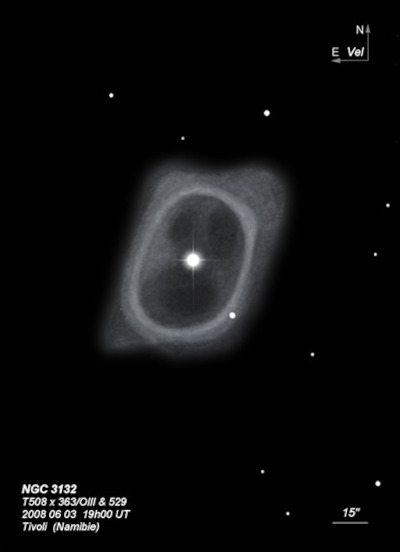
John Herschel discovered NGC 3132 = h3228 on 2 Mar 1835 and recorded "Planetary nebula, very large, very bright, elliptic; has in it a 9th mag star somewhat excentric. Its light is exactly equable, ie. not increasing towards the middle; yet I cannot help imagining it to be closely dotted. It is just like a star out of focus in certain states of the mirror and atmosphere. Three stars near, a = 9th mag; b = 9th mag; c = 14th mag; A very extraordinary object." On a later observation he logged, "Planetary nebula with a 10th mag star in centre; very bright; very well defined, and perfectly equable all over in light, there being no condensation up to the centre. The star is sharp, the nebula velvety, or like infinitely fine dust; a star 14th mag at a distance rather more than a radius of neb from edge (by diagram); has its position from centre = 333.8°." Sketch on Plate VI, figure 9.
Herschel sketched NGC 3132 and other planetary nebulae from the Cape of Good Hope, commenting: "[these] represent planetary nebulae, a class of special interest, and of which, considering their general rarity, the southern heavens have afforded a rather unexpectedly large harvest. Those only are here delineated which have either accompanying stars, or which are distinguished by some peculiarity, as ... [NGC 3132] which has a star or a small disc near its centre". Father Angelo Secchi published a sketch (fig. 16) and description in 1856 using the 9.6" refractor in Rome. He called it a "beautiful and large ring nebula similar to that of the Hydra [NGC 3242]." William Lassell also made a sketch on 16 Apr 1862 through his 48-inch on Malta, showing an annual structure. He noted "the centre is bright and evidently stellar. There is a minute star touching the south preceding side of the nebula. Thie sides of the nebula are flattened and better defined than the ends."
In "Southern Gems", Stephen O'Meara states James Dunlop discovered NGC 3132 while making observations for the 1826 Brisbane Star Catalogue (published in 1835). In a footnote to #3085 he noted "Dusky Yellow - a fine Planetary disk." John Herschel recognized Dunlop's observation in a letter to Thomas Maclear in 1835.
A star (HD 87892) is plotted at the position of NGC 3132 in the first edition of the Uranometria 2000 because the BD catalogue (used as a source for the U2000) listed the bright "central" star as an entry. In 1977 Kohoutek and Laustsen announced (1978IAUS...76..207K) that the actual illuminating star is a hot, dim 16th magnitude companion to the mag 10 star at only 1.65" separation. The pair probably forms a true binary
The nickname "Eight Burst Nebula" was coined by H. Shapley and J. S. Paraskevopoulos in "Photographs of Thirty Southern Nebula and Clusters" (1940PNAS...26...31S). Concerning NGC 3132 they say: "A series of photographs of varying exposures would be necessary to bring out the intricate details…. It could well be named the "8-burst" planetary from the number of distinct arcs on the boundary of the main disk or shell".
200/250mm - 8" (3/28/81): mag 9 central star surrounded by a fairly bright, moderately large disc, striking.
300/350mm - 13" (2/23/85): darker around the central star at high power.
400/500mm - 17.5" (3/28/87): very bright, moderately large, oval. A dark ring surrounds the bright mag 10 central star. Viewed at only 10°-11° elevation.
Notes by Steve Gottlieb
NGC 2736
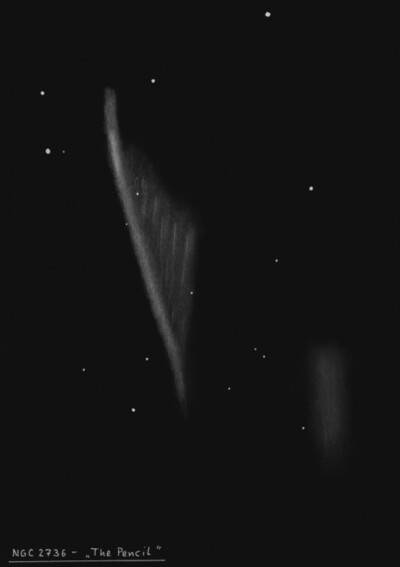
John Herschel discovered NGC 2736 = h3145 on 1 Mar 1835 and recorded "eeF, L, vvmE; an extraordinary long narrow ray of excessively feeble light; position 19 deg±. At least 20' long, extending much beyond the limits of the field...". His position and sketch (Plate V, figure 12) agrees perfectly with ESO 260-N14, the brightest piece of the huge Vela SNR, centered ~ 5 degrees WNW.
Joseph Turner sketched NGC 2736 on 26 Jan 1876 using the Great Melbourne Telescope (plate IV, figure 34 at www.docdb.net/history/texts/1885osngmt________e/lithograph_m_4_34.php). Besides a thin ray, he also saw nebulosity spreading out from the southern end towards the west. In Jan 1885, Barachi commented, "Extremely faint, a long streak across the field, straight, very narrow, with a peculiar group of stars in the n.f. quadrant, forming almost a semicircle, of which the north portion of the streak is the diameter. Streak spreads out at its s.p. end, and becomes a large irregular-shaped whitishness, without distinct contour, which the eye cannot see except by moving the telescope up and down, and only when the back ground is perfectly black and free from haze; even then it requires a little time before it can be seen."
RNGC and NGC 2000.0 misclassify this filament as a galaxy and I mentioned this error in RNGC Corrections #5. The first reported connection of NGC 2736 with the Vela SNR was in 2000: http://www.journals.uchicago.edu/ApJ/journal/issues/ApJL/v543n2/005648/005648.html, two years after the discovery of the SNR itself in 1998. Estimated age of the supernova is 9-11,000 years.
300/350mm - 13.1" (2/18/04 - Costa Rica): Herschel's Ray was easily picked up at 105x using a UHC filter. It extended well over 1/2 of the 38' field, at least 20'x2', oriented SSW-NNE. This prominent Vela Supernova filament is brightest towards the NNE end near a mag 8.3 star which is just following the NNE edge. It appears like a thin splinter of light through the field with a weak filamentary structure and variations in brightness, similar to one of the fainter filaments in the Veil nebula. Several stars are very close to the edge including a mag 11 star near the middle. I was impressed the appearance was very comparable to the view I had through the 18-inch in Australia.
400/500mm - 18" (7/7/02 - Magellan Observatory, Australia): this is an isolated bright eastern filament in the Vela Supernova remnant which is centered over 4° to the west. At 128x and UHC filter (38 arcmin field), it appears as a fairly faint, thin, nebulous streak extending SSW-NNE over half the field, ~20'x1'! The surface brightness is roughly uniform, though the northern portion is brighter near a mag 8.3 star off the NE end. The nebulosity continues past this star and ends with a mag 9.5 star due east of the NNE tip. On the SSW end the nebulosity gradually dims out. A few mag 11 stars border the filament, one just off the west edge near the center and a couple further south.
600/800mm - 24" (4/11/08 - Magellan Observatory, Australia): Herschel's Ray was a striking, bright filament at 130x and a UHC or OIII filter, extending SSW-NNE for at least 20' in length. Herschel's Ray is brightest along a 5' stretch at the NNE end as it passes to the west of mag 8.3 HD 774433 and continues NNE ending to the west of a mag 9.5 star. Several very faint stars appear to very close to the northern half of the ray, particularly along the eastern edge, though a mag 11.2 star is also at the western edge. The ray weakens or thins to a narrow splinter just the east of this mag 11.2 star. At the NNE tip the filament subtly bends very slightly towards the north and at the SSW end the filament more obviously curves or hooks slightly towards the south as it fades.
Notes by Steve Gottlieb
NGC 2547
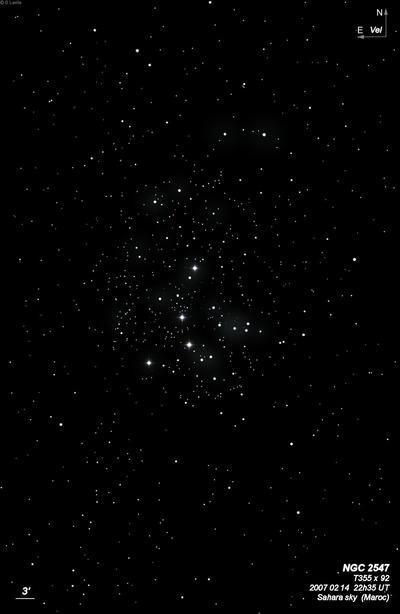
Nicolas-Louis de Lacaille discovered NGC 2547 = Lac III-2 = D 410 = h3117 in 1751-1752 using a 1/2-inch telescope at 8x during his expedition to the Cape of Good Hope. He described III-2 as "five faint stars like the letter T in nebulosity." Dunlop observed the cluster twice recording "A curiously arranged group of pretty bright small stars of mixt magnitudes. This answers to the place of 310 Argus (Bode) and is described by Lacaille as nebula with five small stars forming the letter T in it. There is no nebulosity in this place. The diameter of the cluster may be about 12'. Figure 16 [in his publication] is a very good representation of the group."
John Herschel first logged the cluster on 28 Dec 1834 and recorded "chief star 7th mag about, of a vL, loose, brilliant cluster of very scattered stars, 1 of 7th mag, 2 of 8th mag, rest 9...16th mag. Fills more than field; 100...150 stars." JH inadvertently equated this cluster with D 411 instead of D 410 and this error was copied into the NGC.
300/350mm - 13.1" (1/30/06 - Costa Rica): this naked-eye cluster to the south of Gamma Velorum (bright binocular double) is roughly 30'x20' in size. There is a very distinctive, gently curving arc of stars bowed out to the east that defines the eastern side of the central region and the brightest mag 6.5 star (HD 68478) is along this arc. Three nice pairs are to the west and NW of the mag 6.5 star (one of these pairs has a third fainter companion forming a triple). The main portion of the cluster is enclosed in two outer strings of stars that form a large "V" with the vertex to the east of the mag 6.5 star and the pair of strings increase the diameter to 30'. While scanning for NGC 2547 I ran across a bright, distinctive red star to the west (probably M3-class HD 67821).
13.1" (2/18/04 - Costa Rica): this is a very bright naked-eye cluster that includes a number of mag 7-8 stars. It appears at least 20'-25' in diameter, though the outer boundaries are pretty arbitrary. Very unusual arrangement as a number of the brighter stars form a curving arc which is bowed out towards the east and which defines the eastern border of the cluster! The brightest mag 6.5 star is within this arc on the south side of the cluster. The cluster is encased in faint reflection nebulosity, though this was not visible.
Notes by Steve Gottlieb
NGC 3201
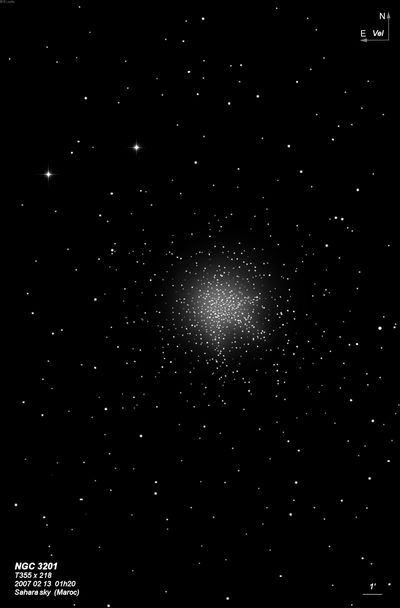
James Dunlop discovered NGC 3201 = D 445 = h3238 on 1 May 1826 with his 9-inch reflector at Parramatta, NSW, and described a "pretty large, pretty bright round nebula, 4' or 5' diameter, very gradually condensed towards the centre, easily resolved into stars; the figure is rather irregular, and the stars are considerably scattered on the south preceding side: the stars are also of slightly mixed magnitudes."
John Herschel first observed NGC 3201 on 20 Apr 1836 and recorded a "globular cluster, irregularly round, gbM, not v m comp, 6', resolved into stars 13...15th mag." On a second sweep he called it "irregularly round, 7' diameter, but the outliers extend to at least 10' or 12'; gpmbM, but not very much compressed; all resolved into stars 13..16th mag."
NGC 3201 is 7th in ranking of brightest member stars (mag 11.7) and 10th in ranking of horizontal-branch mag (mag 14.8). The distance is ~20,000 light years.
300/350mm - 13" (2/23/85): this fairly bright globular cluster appears fairly large and mottled. But only a few stars were resolved due to the view being compromised by the very low elevation (~5° altitude) from northern California.
400/500mm - 18" (7/8/02 - Magellan Observatory, Australia): beautifully resolved globular at 171x and 228x. The cluster is fairly large, ~8'-10' diameter with more careful viewing. Roughly 150 stars were resolved, though the number grew with magnification and averted vision. A fairly dense layer of brighter mag 11.5-12 stars were resolved right over the bright core. The halo, which has a large number of mag 13 stars, had a scraggly, irregular edge and seemed elongated - possibly partially obscured by dust. This concentration class X cluster is 7th in ranking of brightest stars (mag 11.7) and 10th in horizontal-branch mag stars (mag 14.8).
600/800mm - 24" (4/11/08 - Magellan Observatory, Australia): at 200x, this beautiful, loose globular was well resolved with approximately two hundred mag 12 to 16 stars visible within a 10' region. An unusual feature is the large number of brighter cluster stars that appear to be superimposed right on top of a fainter layer of stars in the central core. The core seemed displaced towards the north side as if part of the northern half of the cluster was obscured and flattened. This apparent affect may also be due to a larger number of brighter resolved stars that are superimposed on the northern half of the core. A number of stars in the outer halo are arranged in strings and chains and the outer extent of the halo is irregular.
Notes by Steve Gottlieb
IC 2391
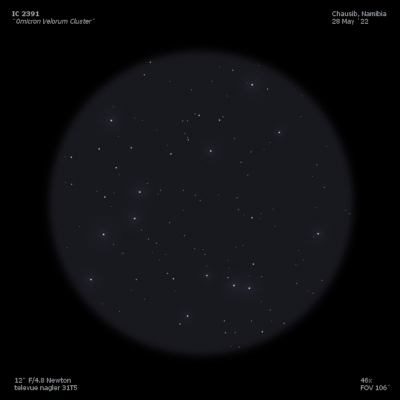
Persian astronomer Al-Sufi first mentioned IC 2391 = Lac II-5 in his "Book of Fixed Stars" (964 AD) as a "nebulous star." Nicolas-Louis de Lacaille observed it in 1751-1752 during his journey to the Cape and described a "small heap of stars" in his 1/2-inch refractor. Solon Bailey also found the cluster on a photographic plate in 1896 using a 1" (f/13) Cook lens at the Arequipa station. The discovery was reported in "A Catalogue of Bright Clusters and Nebulae" (Annals of Harvard College Observatory, Vol LX, No. VIII) and Bailey was credited with the discovery in the IC.
300/350mm - 13.1" (1/30/06 - Costa Rica): very bright and large naked-eye cluster surrounding mag 3.6 Omicron Vel (just north of the False Cross). Resolved in 9x50 finder and my 15x50 IS binoculars. Includes 7 bright stars with a wide (1.3') bright pair of mag 5 stars on the east side. The border of this scattered group is not well defined but the fainter stars fill out over a degree in the 20mm Nagler 66' field.
13.1" (2/17/04 - Costa Rica): this very large naked-eye cluster appears as a fuzzy glow surrounding mag 3.6 Omicron Velorum (1.8° NNW of mag 2.0 Delta Velorum in the False Cross). This scattered 50' group contains perhaps three dozen stars and barely fits in the field of the 20mm Nagler. Perhaps a better view was obtained in the 9x50 finder or 10x30 IS binoculars which did a nice job of resolving the brighter stars, but the group was really too sparse and scattered to look impressive in the 13".
10x30mm Canon IS (3/28/19 - Tasmania): very bright naked-eye cluster with a few stars seen unaided. Excellent resolution in 10x30 binoculars but still scattered as spread out over 50'. Nice wide double star at edge. Includes a half-dozen brighter stars.
Naked-eye - (3/16/18, West Texas): I noticed the Omicron Vel cluster was fairly easily visible naked-eye as a fuzzy patch, though only 7° (or less) elevation at a latitude of +30. It was partly resolved in 10x50 binoculars.
Notes by Steve Gottlieb
IC 2395
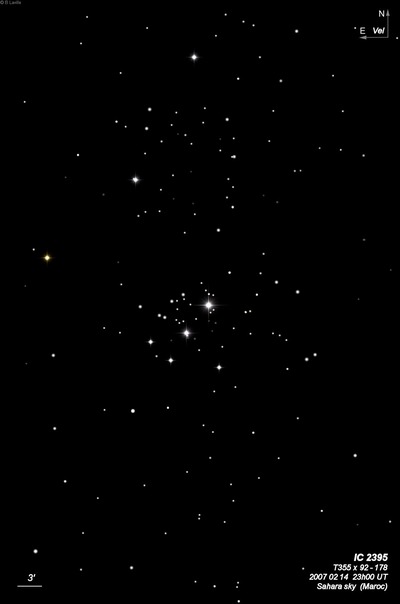
Nicolas-Louis de Lacaille discovered IC 2395 = Lac. III-3 between 1751-1752 during his expedition to the Cape of Good Hope. He recorded "Star of 6th magnitude, connected to another more southern one by a nebulous trail." Solon Bailey independently discovered the cluster photographically in 1896 with a 1" Cook lens at the Arequipa station in Peru. The discovery was published in his 1908 paper "A Catalogue of Bright Clusters and Nebulae, Annals of Harvard Observatory, Vol LX, No. VIII. Dreyer missed Lacaille earlier discovery and Bailey is credited in the IC.
Brent Archinal noted the equivalence of this cluster with vdB-Ha 47. The Lynga position for IC 2395 is incorrect but OK for vdB-Ha 47. Brian Skiff gives a centroid position of 08 42 31 -48 06.5 (2000).
300/350mm - 13.1" (2/18/04 - Costa Rica): this bright naked-eye group includes mag 5.5 HX Velorum on the west side. Resolved in the 9x50 finder. In the 13.1", roughly three dozen stars are visible in a 10' field. The bright stars are scattered mostly on the following side of the group in an elongated arrangement extending to the southeast. There is also a fairly rich gathering of stars within 4' of HX Vel. NGC 2660 is located 48' S.
Notes by Steve Gottlieb
NGC 2899
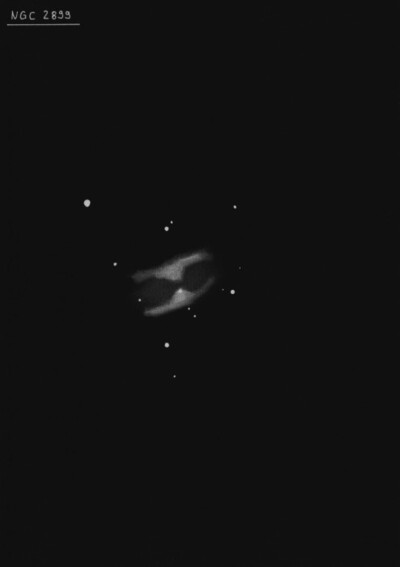
John Herschel discovered NGC 2899 = h3169 on 27 Feb 1835 and recorded "F; pL; R; glbM; 80". At least 80 stars in field." His position is accurate.
300/350mm - 13.1" (2/18/04 - Costa Rica): at 105x this interesting Vela planetary appeared fairly faint, moderately large, slightly elongated ~E-W, 1.3'x1.0'. Good contrast gain with a UHC filter. The surface brightness appears very irregular or mottled with a brighter knot on the SW end that is nearly detached and an irregular darker center. Also a less-defined knot appears to be situated on the north end. Four mag 7.5-9 stars are in the field to the west and north and the PN is situated 9' E of mag 7.3 SAO 236965. The faint planetary Wray 17-31 = VBRC 2 lies 38' ESE
400/500mm - 18" (7/8/02 - Magellan Observatory, Australia): at 171x, this moderately bright planetary is fairly large, ~1.5'x1.0', with an irregular shape and surface brightness. Adding a UHC filter improved the contrast and the PN is clearly elongated with an annular or bi-polar appearance with a darker, irregular center. There are two brighter knots or arcs on on the SW and NE sides of the central section (minor axis?) with the SW knot more obvious. Situated in a fairly rich star field with four mag 7-9 stars including a mag 7.3 star 9' W.
600/800mm - 24" (4/10/08 - Magellan Observatory, Australia): fascinating bipolar planetary at 260x using a UHC filter. A very bright knot is situated on the SW end with fainter extensions along the rim to the SE. A matching knot with a lower surface brightness is on the north side. This knot is also elongated, making another short arc. Overall, NGC 2899 is noticeably elongated with dimensions of ~1.6'x1.0', oriented NW-SE. At 520x both knots or arcs gradually increase in brightness to their centers and occasionally show very faint stellar nuclei. The overall surface is noticeably mottled at this power, though darker in the center. The open cluster IC 2488 lies 50' S.
Notes by Steve Gottlieb
NGC 3228
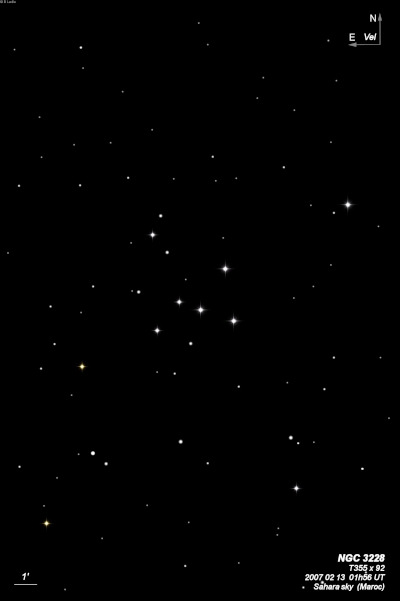
Nicolas-Louis de Lacaille discovered NGC 3228 = Lac II-7 = D 386 = h3245 in 1751-1752 with a 1/2-inch telescope at 8x, during his expedition to the Cape of Good Hope. He described a "heap of four or five faint, very small and compressed." James Dunlop observed the cluster on 9 May 1826 and noted "11 Roboris Caroli. A group of 8 or 10 pretty bright small stars, with very small stars, about 6' diameter." JH recorded (single observation) "a group of 9 L, and a few scattered small stars."
300/350mm - 13.1" (2/18/04 - Costa Rica): bright, 15' open cluster in Vela. Prominent in 9x50 finder and easy in 10x30 IS binoculars. The main portion consists of 9 mag 8-10 stars. Scattered about are a few additional mag 9 and 10 stars in a 15' field. Perhaps 3 dozen stars total are within the boundary, though besides the bright stars the remaining are mostly mag 13-14 and appear to be a random background scattering of stars in a rich Milky Way field.
Notes by Steve Gottlieb
NGC 2669
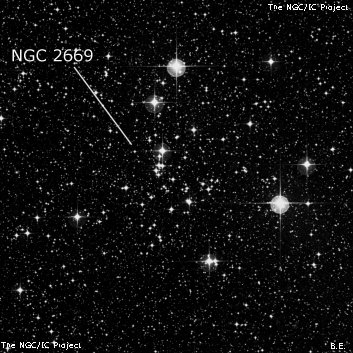
John Herschel discovered NGC 2669 = h3140 on 11 Apr 1834 and recorded "Cluster VIII class. A L, poor, loose cl of stars, 10...13m." The position was noted as very uncertain, with the RA to the nearest (+/-) minute. There is nothing resembling even a poor cluster near his position. Dreyer credited Persian astronomer Al-Sûfi with the discovery of NGC 2669, but Al-Sûfi mentioned IC 2391 instead.
According to Archinal and Hynes in "Star Clusters", in 1930 Robert Trumpler found the most likely candidate for Herschel's missing cluster. He noted "NGC 2669 - Declination of NGC corrected by +1°.", which corresponds with ESO 165-SC5. This cluster fits JH's description though Archinal comments that several of the stars are brighter than mag 10...13. He also mentions that Harvard 3 (from Shapley's 1930 Monograph on star clusters) refers to a part of NGC 2669.
300/350mm - 14" (4/3/16 - Coonabarabran, 145x and 178x): fairly rich group of ~60 stars in a 6' or 7' region, elongated N-S. Includes a mix of brighter mag 9.5-11 stars, along with a number of faint mag 14-15 stars. A mag 9.5 star and five mag 11-12 in a 1.5' N-S string, is on the northeast side. The cluster is bounded by a striking number of very bright stars including mag 7.6 HD 75105 off the southwest side, mag 8.2 HD 75227 and mag 7.7 HD 75202 off the north side, and mag 8.6 HD 75167 off the south side (20" pair with a mag 11 star). The group spans at least 12' to 14' if you include these bright stars. Located ~55' E of IC 2391 (surrounding mag 3.6 Omicron Velorum).
Notes by Steve Gottlieb
NGC 2645
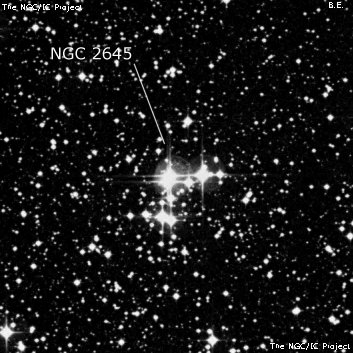
John Herschel discovered NGC 2645 = h3136 on 29 Dec 1834 and described a "close group or small cluster of 12 or 13 large and small stars; place of a double star, the chief one." This cluster is equivalent to Pismis 6 with the nearly central pair HD 73919/CoD-45 4352 at 08 39 04 -46 13.6 (2000). Paris Pismis reported the cluster as new in her 1959 list of clusters found on Tonantzintla Schmidt plate and commented, "Two pairs of doubles, including the brightest star."
RNGC classifies NGC 2645 as nonexistent (Type 7) and Lynga labels the cluster Pismis 6 without reference to NGC 2645.
300/350mm - 14" (4/5/16 - Coonabarabran, 145x and 178x): bright compact group with a dozen stars packed into a 2' region. Contains 4 very bright stars forming a right angle, including a striking pair of mag 9 stars (HJ 4122) at 11" separation. A third mag 9 star is 1' W of the pair and another mag 9.5 star is 1' SSE. The latter star is also a double with a mag 10.5 companion at 16" separation. This knot of bright stars is situated 15' ENE of mag 6.9 HD 73658.
Notes by Steve Gottlieb
NGC 2910
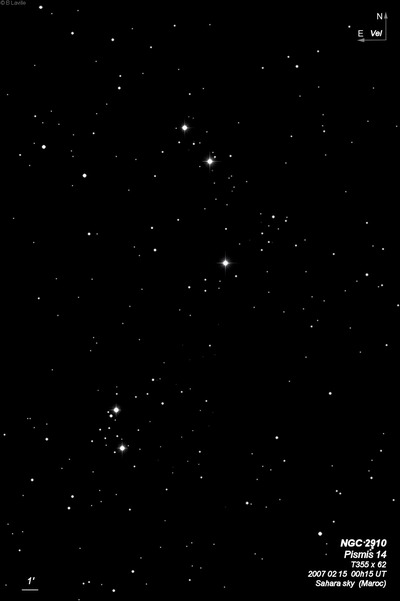
10x30mm Canon IS (3/28/19 - Tasmania): faint, small, roundish, no obvious resolution. Not difficult to identify just northeast of the "False Cross".
John Herschel discovered NGC 2910 = h3171 on 10 Apr 1834 and recorded "Cluster of loose stars; p rich; stars 11...15m; has rather a vacancy in the middle; fills about 2/3 of field." On a later sweep (763) he measured an accurate position on a bright star at the southeast side of the cluster.
400/500mm - 18" (7/8/02 - Magellan Observatory, Australia): ~50 stars are resolved in an oval or "racetrack" outline oriented NW-SE, perhaps 6'x4', with outliers making the group rounder. Includes a half-dozen stars brighter than mag 11. The SE end of the oval has a rich subgroup over unresolved haze. No concentration, in fact the center of the "racetrack" is nearly devoid of stars!
Notes by Steve Gottlieb
NGC 3330
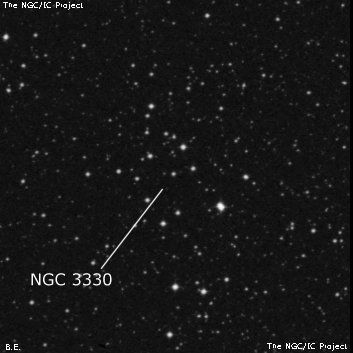
10x30mm Canon IS (3/28/19 - Tasmania): fairly faint but easily seen, a couple of stars were resolved at the edges.
James Dunlop discovered NGC 3330 = D 355 = h3287 on 29 Apr 1826 and described "a triangular group of small stars resembling faint nebula, with several stars in it of some considerable magnitude." This was the first object he discovered with his homemade 9-inch speculum reflector after recording a few known objects. JH recorded on 6 Apr 1834 "The chief star (9th mag) of a poor cluster of 20 or 30 stars."
300/350mm - 13.1" (2/18/04 - Costa Rica): at 105x, ~30 stars mag 10-13 in a 6'x3' group elongated N-S. Three brighter mag 10 stars are on the south side but the main group of stars is on the north side including another mag 10 star. This was an easy object in my 10x30 IS bincoculars and was partially resolved in the 9x50 finder.
Notes by Steve Gottlieb
IC 2488
10x30mm Canon IS (3/28/19 - Tasmania): moderately bright, large, a few stars resolved over the hazy glow of unresolved stars. Picked up 0.5° W of mag 3.2 N Vela.
Nicolas-Louis de Lacaille discovered IC 2488 = Lac III-4 = D 330 between 1751-1752 using a 1/2-inch telescope at 8x during his expedition to the Cape of Good Hope. James Dunlop described D 330 as "A faint cluster of small stars of mixed magnitude, with two or three pretty bright stars in it. This answers to 485 Argus (Bode) and is described as a small star surrounded by a nebula." Solon Bailey also found the cluster on a photographic plate in 1896 using a 1" f/13 Cook lens at Arequipa station. The discovery was reported in "A Catalogue of Bright Clusters and Nebulae" (Annals of Harvard College Observatory, Vol LX, No. VIII). As John Herschel never observed the cluster it wasn't included in his GC or the NGC. Dreyer only credited Bailey with the discovery in the IC.
600/800mm - 24" (4/10/08 - Magellan Observatory, Australia): very large, very bright cluster at 84x but fairly scattered. The most striking portion are two bright ~N-S strings of stars, each ~5' in length, on the SE side of the cluster. These two strings are connected on the north end by a couple of stars forming a "U" outline. Many of the other stars are also arranged in strings including streams of stars that extend to the NW on both the north and south side of the cluster. The most prominent string starts at the northern end of the western row and extends NW to a mag 9.4 star. The outline of the cluster then meanders south on the west side before heading back SE towards the two parallel strings. Although the listed diameter is 70', my description applies to the central 15' portion of the cluster. Located 30' W of mag 3.1 N Velorum. The irregular planetary, NGC 2899, lies 51' N.
Notes by Steve Gottlieb
NGC 2670
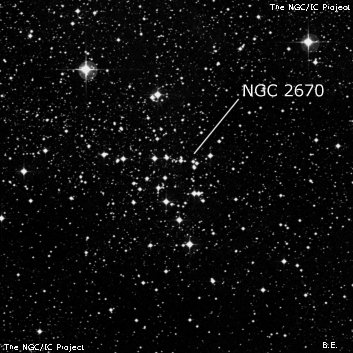
John Herschel discovered NGC 2670 = h3142 on 18 Feb 1836 and recorded "a cluster 8th class, not rich, nor much compressed; 8' in diameter, irr round, stars 13 mag." His position is accurate.
300/350mm - 13.1" (2/20/04 - Costa Rica): at 166x, this fairly bright open cluster has an unusual appearance. Roughly two dozen stars mag 10-12 are arranged in a "wishbone" arrangement with a distinctive string of stars running SW-NE with the brightest mag 9 star on the SW end, with another string running E-W and a third side running N-S. The group is ~6' in diameter.
Notes by Steve Gottlieb
NGC 2925
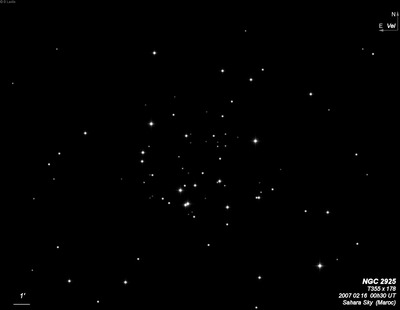
John Herschel discovered NGC 2925 = h3177 on 5 Jan 1837 and recorded "a pretty rich cluster, 8th class; a double star (one of the chief) taken." His position is at the southeast edge of the cluster and the double is HJ 4221.
300/350mm - 14" (4/3/16 - Coonabarabran, 145x and 178x): scattered cluster with 60+ stars mag 8.5 and fainter in a 10' region. The brightest stars roughly define the outline, including mag 8.5 HD 82812 at the west end. On the south side is HJ 4221, a 9.4/9.9 pair at 15" and three mag 9-10 stars are on the east side. Mag 7.7 HD 82737 lies 13' SW.
Notes by Steve Gottlieb
NGC 2659
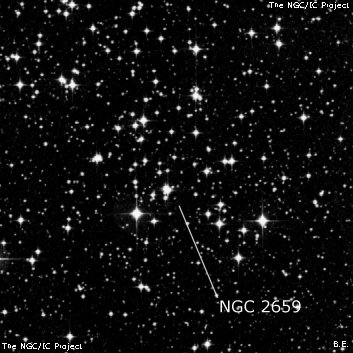
John Herschel discovered NGC 2659 = h3137 on 3 Feb 1835. His second more detailed description reads "Cluster VII class; p rich, pL, 12' l, 8' br; fig irreg; rather branching stars 11..14th mag, not compressed in middle." Both descriptions give a much larger size than I noted in my observation.
300/350mm - 13.1" (2/20/04 - Costa Rica): bright, compact group with 15-20 stars in a 4' group including five mag 10-10.5 stars and a distinctive brighter pair. This cluster is in the same field as the Vela Supernova Remnant, though I didn't search for filaments in this region.
Notes by Steve Gottlieb
NGC 2660
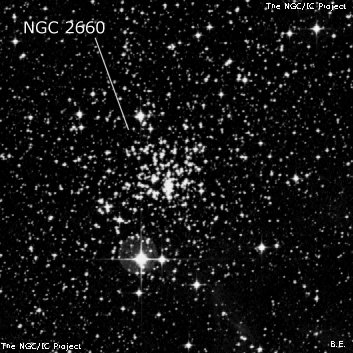
John Herschel discovered NGC 2660 = h3138 on 29 Dec 1834 and recorded a "Cl VI cluster; irreg R; gbM; 4'; resolved into distinct stars 14m." His position (measured on 2 sweeps) is accurate.
300/350mm - 13.1" (2/18/04 - Costa Rica): this distant cluster appeared relatively faint, small, and was only partially resolved. It appeared ~2' in diameter and comparable to a faint globular cluster. A few faint stars were resolved on the west side and an unresolved brighter knot of stars resides on the south side. The cluster is wedged between a yellow/orange mag 8.4 star 2.5' S and a mag 10 star to the north. Located 16' ENE of mag 4.7 HD 74272.
Notes by Steve Gottlieb
NGC 3033
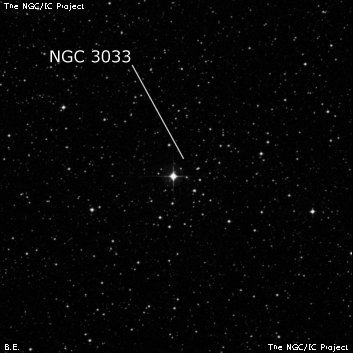
John Herschel discovered NGC 3033 = h3194 on 27 Feb 1835 and logged "irregularly round cluster, 8' diameter, of 50 or 60 stars, 11 and 12 mag. In the milky way, but sufficiently rich and distinct to be registered as a cluster."
600/800mm - 24" (4/10/08 - Magellan Observatory, Australia): at 200x, this is a small 4' group of ~30 stars situated just SW of mag 6.1 HD 85250. Many of the stars are arranged in a loop or oval on the SW side of the star, so the combination with the bright star appears similar to a diamond ring. The cluster members are fairly uniform in brightness with a number of mag 11 stars. A wide double star 5' SE (9.5/11.5 at 26") is collinear with HD 85250.
Notes by Steve Gottlieb
NGC 3105
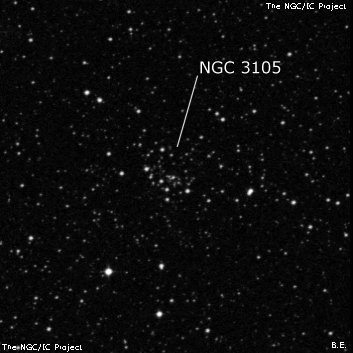
John Herschel discovered NGC 3105 = h3219 on 10 Apr 1834 and recorded "a small close clustering knot of stars 13-16 mag; oval; a great train of stars 12..13 mag on the S.p. side." HIs position is an exact match with this small cluster. Trumpler (Lick Obs Bul, Vol 14, No. 420) gives the diameter as 2.5' and the class as 2 2 p.
600/800mm - 24" (4/11/08 - Magellan Observatory, Australia): fairly bright compact cluster of just 2.5' diameter with 15 stars resolved at 200x. Using 350x the total increases to ~20 stars in a 2.5' region. A close unequal double is close west of center. A 25" pair of mag 11.5 stars lies 3' NE. Located 3' NW of a mag 9.6 star. Located 36' ESE of mag 3.5 Phi Velorum.
Notes by Steve Gottlieb
NGC 2972
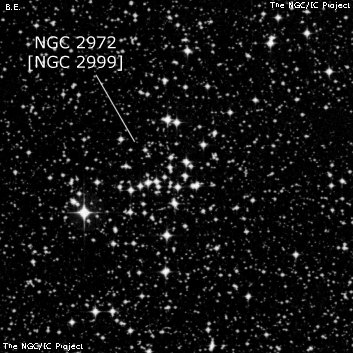
600/800mm - 24" (4/11/08 - Magellan Observatory, Australia): at 200x, three dozen stars are resolved in a 4' group. Most of the stars are arranged in two intersecting rows forming an "X" shape. One part of the "X" is a 2' E-W string through the center of the group. A few brighter stars are south of this string and these form another string that intersects and continues to the NW. Also a 15" pair is less than 2' N of the E-W string. Located about 2.5' W of a brighter mag 9.4 star.
Notes by Steve Gottlieb
NGC 3261
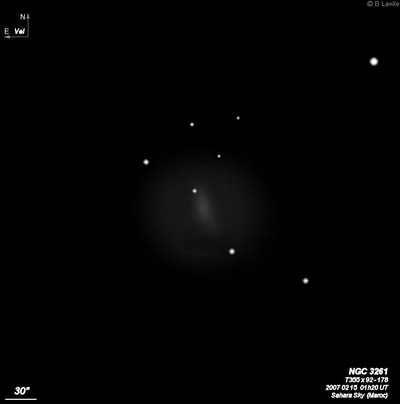
John Herschel discovered NGC 3261 = h3258 on 15 Mar 1836 and recorded "F; S; R: 15"; entangled among 2 or 3 stars, but is certainly a nebula." His position matches ESO 263-040.
300/350mm - 13.1" (2/18/04 - Costa Rica): fairly faint, moderately large, elongated 2:1 ~WSW-ENE, 1.4'x0.7', weak concentration. Bracketed between two mag 12 stars at the SW and NE ends (separation 2.6'). Located 4' SE of a mag 10 star in a rich Vela starfield. NGC 3261 is in a subgroup of the Hydra-Centaurus Supercluster (brightest member NGC 3256) and is 9° south of the rich Antlia Cluster (but has the same redshift).
Notes by Steve Gottlieb
NGC 3256
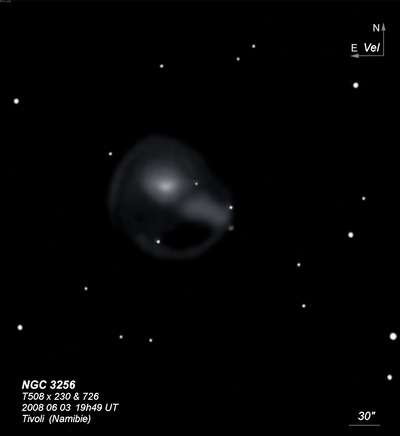
NGC 3256 is a member of the Hydra-Centaurus Supercluster and possible outlying member of the Antlia Cluster (9 degrees north). This cluster was first catalogued as Klemola 12. On photographs NGC 3256 is a chaotic system that appears to be undergoing a spectacular merger with long tidal tails. This starburst galaxy is a superluminous infrared source with X-ray emission.
John Herschel discovered NGC 3256 = h3254 on 15 Mar 1836 and recorded "B, R, gmbM, 25"." His position (measured on two sweeps) matches ESO 263-038. Joseph Turner observed it on 24 Feb 1879 with the 48" Melbourne Telescope and noted "it is considerably elongated, the densest section being towards the north-following extremlty, the faint section extending in the south-preceding direction."
300/350mm - 13.1" (2/18/04 - Costa Rica): this disturbed galaxy appeared as a moderately bright and large oval, extended 3:2 NW-SE with dimensions 1.6'x1.2'. It contained a fairly bright 1' round core embedded in a very faint halo. NGC 3256 is the furthest north and the brightest in a group of Vela galaxies stretching south to NGC 3261, located 46' to the SSE.
600/800mm - 25" (4/1/19 - OzSky): at 244x; bright, very large, oval 4:3 NW-SE, ~1.6'x1.2', pretty sharply concentrated with a very bright relatively large core that appears off-center. The halo is irregular in brightness. The tidal plumes extending east from the north end and stretching west were not seen in dewy conditions.
NGC 3256C, a highly disrupted galaxy (interacting with NGC 3256) situated 14' ENE, appeared fairly faint, roundish, ~35"-40" diameter. Fairly low but uneven surface brightness, weak concentration. Situated 4' E of mag 6.7 HD 90898. The galaxy is just east of semi-circular chain of stars on the east side of HD 90898. The chain includes three double stars as well as a triple!
Notes by Steve Gottlieb
NGC 2792
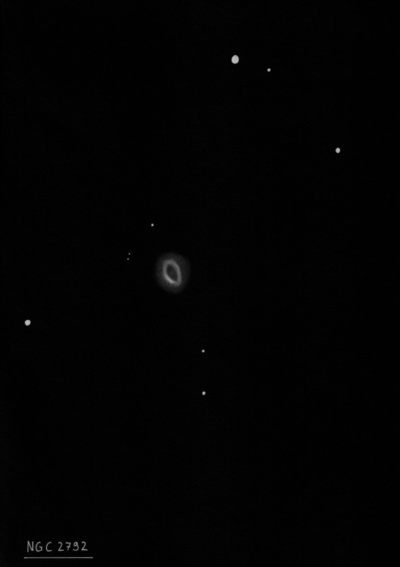
John Herschel discovered NGC 2792 = h3149 on 2 Mar 1835 while observing with Thomas Maclear and another guest. He recorded, "pF, exactly round, equal to a star 9th mag, but of a dull light. At first I was inclined to think it double, but with 320 it exhibited a uniform round disc; nor did a friend to whom I showed it see any division. Stars to-night perfectly well defined. In a field with leading stars, or which a diagram was made." On 7 Feb 1837 (his third observation of the planetary), he noted "Viewed past meridian. It occurs in a field with about 40 stars. Diameter 4" or 5" at the utmost; 10" is too large certainly. Very like that of sweep 771 [NGC 2452]. But now the night is good and it bears magnifying. With 320 power the disc is dilated into a dim hazy round nebula; yet there is a peculiarity in its appearance which completely separates it from all nebulae of the same size. A very remarkable object."
Robert Innes, observing on 16 Mar 1917 with the 9-inch refractor at the Union Observatory in Johannesburg, described NGC 2792 as "an 11th magnitude planetary about 20" in diameter. Is north preceding a pair of 10.5 mag stars. No stars within 3'."
300/350mm - 13.1" (4/10/86): moderately bright planetary, small, round, no central star. A pair of mag 11 stars at 36" separation is located 4' SE. Very far southern object for observation from Northern California.
600/800mm - 24" (4/4/08 - Magellan Observatory, Australia): at 350x this high surface brightness planetary appeared very bright, small, round, 15"-20" in diameter. It appeared annular with a brighter rim, although the the inner edge of the annulus was not well defined. A wide pair of mag 11 stars lies 4' SE. Located 13' SW of mag 6.3 HD 79524.
Notes by Steve Gottlieb
NGC 2626
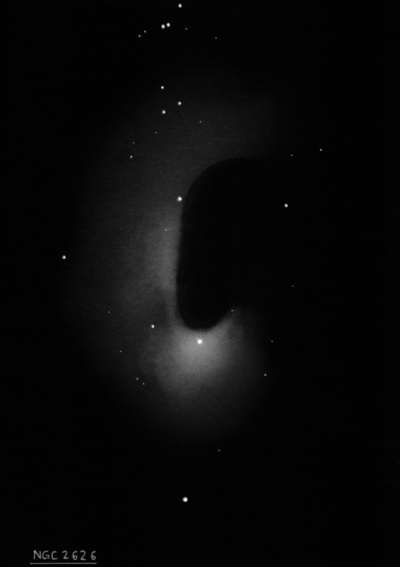
John Herschel discovered NGC 2626 = h3131 on 2 Jan 1835 and recorded "A star 9th mag involved in nebulosity, 3' diameter. In the milky way with multitudes of equal stars all round the neighbourhood, none of which are so affected. Sky quite pure, not the slightest nebulous haze. No doubt. The nebula loses itself imperceptibly, the star being (though excentric) yet in the most condensed part." His sketch was published on Plate VI, figure 12.
Joseph Turner observed and sketched this object on 26 Jan 1876 (unpublished plate V, figure 48) and earlier by Albert Le Sueur (figure 49). The nebulosity is shown as mostly fanning out to the north of the illuminating star but weak directly north, so it made a thick "U" shape around the star. A lithograph of the sketches was completed but not published.
400/500mm - 17.5" (3/23/85): faint, small, diffuse circular reflection nebula surrounding a mag 10 central star. The surrouding, low surface brightness emission nebulosity was not seen, observing at a very low elevation.
Notes by Steve Gottlieb
Hen 2-7
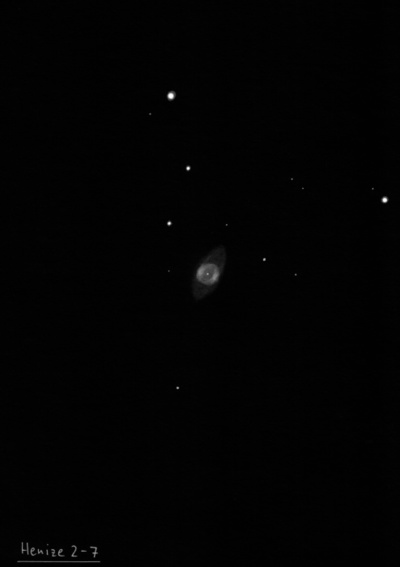
| Type | PN |
| RA | 08:11:31.8 |
| Dec | -48:43:18.0 |
| major_axis | 48.0'' |
| mag | 12.4 |
| surface_bright | 11.5 |
K 2-15
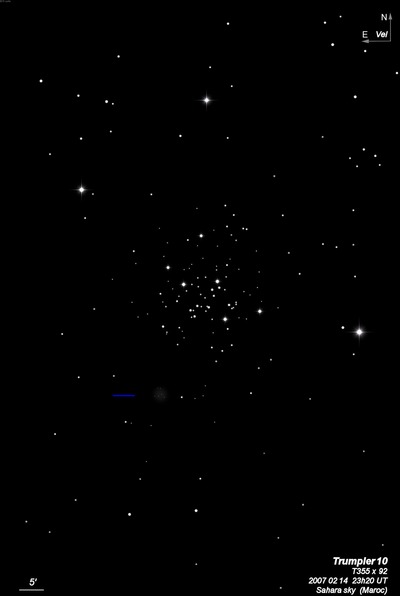
| Type | HII |
| RA | 08:48:39.1 |
| Dec | -42:53:54.0 |
| major_axis | 2.8' |
| mag | 13.4 |
| surface_bright | 15.4 |